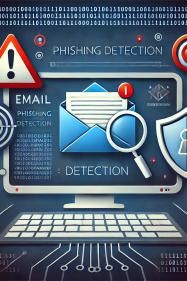Phishing emails are a primary method used by cybercriminals to steal sensitive information. These fraudulent emails often mimic legitimate communications, making them increasingly difficult to identify. Recognizing phishing email tactics and deception techniques is crucial for protecting your data. At Arsen, we provide next-generation awareness training to help employees detect phishing attempts. Here's what to look for when identifying phishing emails.
1. Deceptive Sender Information
One of the first clues of a phishing email is deceptive sender information. Cybercriminals often manipulate the "From" field to make it appear as though the email is coming from a trusted source.
Techniques Used: Attackers may use a display name that matches a legitimate company or contact, but the actual email address may contain subtle alterations (e.g., "support@yourbank-secure.com" instead of "support@yourbank.com").
What to Do: Always inspect the sender’s email address closely. Hover over the "From" address to reveal the full email. If the address looks strange or doesn’t match the official domain of the organization, it's likely a phishing attempt.
You can find some phishing email examples here !
2. Urgency and Fear Tactics
Phishing emails often use scare tactics to pressure recipients into acting quickly. They may claim that your account has been compromised or that immediate action is required to avoid a serious consequence.
Techniques Used: Common phrases include "Your account has been suspended!" or "Immediate verification required!" By creating a sense of urgency, attackers aim to cloud your judgment and prompt you to provide sensitive information without verifying the message's legitimacy.
What to Do: Take a step back and question the urgency. Legitimate organizations will not pressure you into immediate action without verification. Always contact the company directly through official channels if you receive such an email.
3. Mismatched URLs and Links
Phishing emails frequently contain links that appear to direct you to a legitimate website but actually lead to a fraudulent one designed to steal your information.
Techniques Used: Attackers often create URLs that closely resemble official domains but include slight misspellings or extra characters (e.g., "www[.]paypall-support[.]com" instead of "www[.]paypal[.]com"). They may also use link shorteners to disguise the true destination.
What to Do: Hover over any links in the email to see where they lead or use specific phishing detection techniques. If the URL looks suspicious, do not click. It’s safer to visit the official website by typing the URL directly into your browser. We recommend to report any fraudulent email.
4. Unexpected Attachments
Phishing emails may contain attachments that claim to be invoices, receipts, or important documents. However, these files often contain malware designed to infect your device.
Techniques Used: Attackers use a variety of file types, such as .zip, .pdf, or .docx, to entice you into opening them. The email may use urgent language to persuade you to download the attachment without thinking.
What to Do: Never open attachments from unknown senders or unexpected emails. If an email claims to be from a legitimate company but includes an unsolicited attachment, contact the sender through official means to verify its authenticity.
5. Poor Grammar and Spelling Mistakes
While some phishing emails are highly sophisticated, many contain poor grammar, spelling errors, and awkward phrasing. This can indicate that the message was hastily constructed or translated, which is often a sign of a phishing attempt.
Techniques Used: Phishers may use automated translation tools or copy content from legitimate websites, resulting in strange language inconsistencies.
What to Do: If an email contains obvious grammatical errors or unusual language for a professional communication, be skeptical. It’s better to err on the side of caution and verify the message with the supposed sender.
Conclusion
Identifying phishing emails requires a keen eye for deception techniques, such as manipulated sender information, urgency tactics, mismatched URLs, and unexpected attachments. By recognizing these red flags, you can protect yourself and your organization from falling victim to phishing attacks.
At Arsen, we offer advanced awareness training to help employees detect and respond to phishing attempts. Remember, vigilance and skepticism are your best defenses against these cyber threats.

